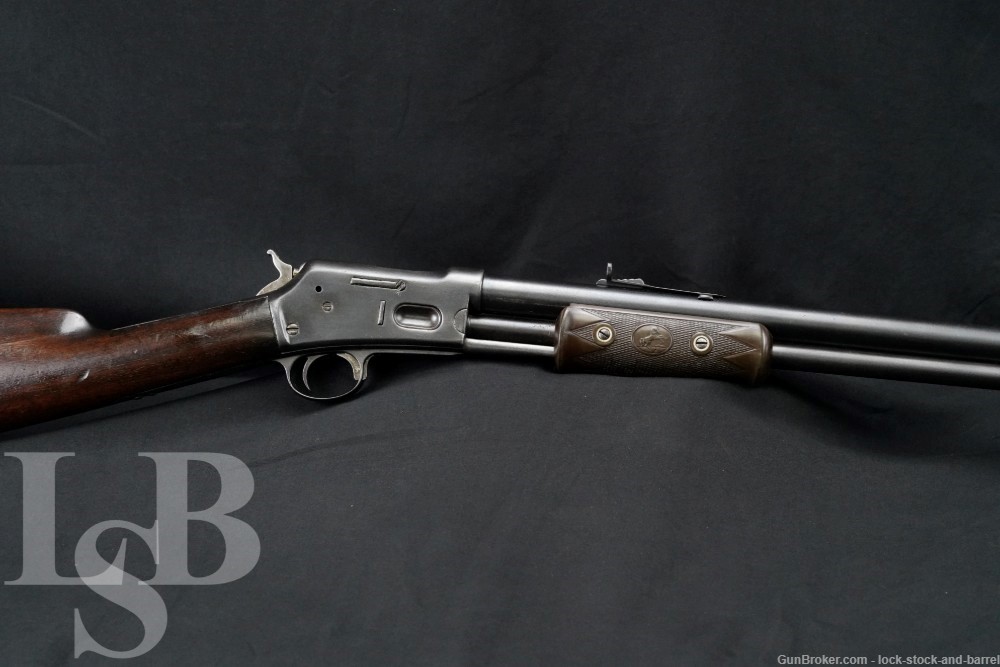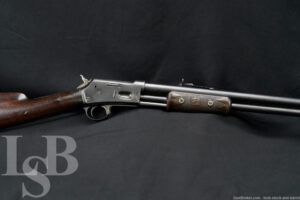
Colt Lightning Magazine Rifle Medium Frame 44-40 CLMR WCF Pump 1887 Antique
SOLD FOR: $2625
LSB#: 230327DY039
Make: Colt
Model: Lightning Magazine Rifle, Medium Frame
Serial Number: 22612
Year of Manufacture: 1887 (https://www.colt.com/serial-lookup)
Caliber: .44 CLMR (.44-40 Winchester)
Action Type: Slide / Pump Action, Full Length Tube Magazine Fed Rifle
Barrel Length: 26”, Tapered Round
Sights / Optics: The front sight is a blade dovetailed and screw-set to the front of the barrel. The rear sight is a “V”-notch elevator sight dovetailed to the rear of the barrel. The top tang is drilled, tapped and filled for a tang sight (none present).
Stock Configuration & Condition: The slide handle is two-piece checkered hard rubber with rampant colt in oval on each panel. The slide handle has some losses at the rear edge of the left panel, otherwise showing fairly light handling wear. The checkering is generally well defined. The buttstock is smooth walnut with a straight grip, straight comb and steel crescent buttplate. The buttstock has scattered nicks, dings, and scratches with a crack at the right-rear. The LOP measures 13 3/8″ from the front of the trigger to the back of the buttplate. The plate has scattered surface erosion which has mostly been scrubbed out, mostly in the white. Overall, the stocks are in Good-plus condition as Antique.
Type of Finish: Blued
Finish Originality: Refinished
Bore Condition: The bore is gray. The rifling is generally strong, interrupted by erosion in some areas. There is scattered light erosion in the bore with a few spots of more moderate erosion and pitting. There is a bulge in the bore at the front sight, it’s not easily visible on the exterior but can be felt if you run your fingers over it. In this writer’s opinion, the bore rates 3 out of 10.
Most antique firearms have bores that will show erosion. This is not only due to age but to the use of black powder. When fired, black powder reacts corrosively. NRA Antique Firearm Conditions Standards are quite lenient for bores. In some cases the NRA standards disregarded the bore’s condition for collectors firearms.
Overall Condition: This rifle retains about 70% of its current metal finish. The new finish is generally strong with the magazine tube gone to a light patina and some other areas of wear which show discoloration from oxidation. There is minor surface oxidation throughout, mostly under the finish. There are some scattered nicks and scratches. There are tool marks at some screw heads. The markings range from clear to worn and incomplete. The rampant colt marking is missing from the left of the frame. The screw heads range from tool marked with strong slots to disfigured with unusable slots. The action shows operational wear. Overall, this rifle is in Fine-plus condition as refinished Antique.
Mechanics: The bolt stop (front of the trigger guard) is fairly loose in its slot and will engage accidentally. Otherwise, the action functions correctly. We have not fired this rifle. As with all previously owned firearms, a thorough cleaning may be necessary to meet your maintenance standards.
Box, Paperwork & Accessories: None
Our Assessment: Around the 1880s, Colt was looking to diversify but both Remington and Winchester had the rifle market sewn up. Besides their lever-actions, there were also new slide action rifles: the user pumped a moving arm set under the barrel and around a tubular magazine, kicking out a spent round and loading a new one with every “stroke”. Colt concentrated on this design concept and in 1884 introduced a gun with a short slide action that was so slick and so fast; they dubbed it the “Lightning”. The advertising said it all: “Nothing was faster than lightning”. Dr. William H. Elliot, a dentist by trade, designed the gun. Half hobby, half side job, Elliot liked to tinker with things and over the course of his life came up with at least 130 inventions. Since he lived in Ilion, New York, he often walked down to neighboring Remington and showed them the interesting things he was working on and when Remington didn’t bite on his new rifle design, he sent a letter to Colt, who loved it.
The handy rifle’s tubular magazine could hold as many as 16 rounds, depending on caliber, which made it very attractive. It came in three varieties: small, medium, and large. Each of these guns had the same set up, with a deep-blued finish, case hardened hammer, American walnut stock and fore-end, and open rear and front sights. They were light, going 6.5-pounds or so. The medium frame guns, chambered for .32-20, .38-40 and .44-40 Winchester calibers, marketed as 32, 38 and 44 CLMR (Colt Lightning Magazine Rifle), were the most popular, using some of the same cartridges as Colt’s Single Action Army and with ammunition already being produced for Winchester’s rifles. Ultimately, the rifle was discontinued as Winchester and Colt came to the agreement that Winchester would produce rifles, Colt would produce handguns, and nobody needed to make the market competition get ugly.
This example is an 1887 vintage Medium frame chambered for .44-40. The rifle has been refinished and the gun shows its age. Apart from the loose bolt-stop, it is in good mechanical condition. This will make for a nice example of the Colt Lightning for a collection and would be well worth restoring, too. Please see our pictures and good luck!
Please forgive any typos, I was educated in California -Bud

